
Buy me a coffee
Nothing helps like coffee when it comes to creating quality content. If you found this post interesting please help my work and invite me for a coffee.
€1.50
Japan’s Supernatural creatures series – Yokai – Part 1

I thought there is no better time to discuss ghosts and spirits than during Halloween season where we are more sensitive to spirituality and ghosts. I hope you will like this article, I also wanted to write about the famous death festival the O-Bon but that will remain a task for the near future.
The most popular and interesting Yokai of Japan

It is seldom to find anything that would be more inherently Japanese than the Yokai.
Japan may be home to the world’s most developed technologies, but not too deep down, the heart of ancient Japan and the ancient mythology is still alive. It breathes, it develops and it’s with every Japanese people for the better or for the worse. Japan has a very peculiar, large and colorful mythological world. While in the face most Japanese confirm to be Buddhist, in reality, peaceful Buddhism is just one side of the mythological coin of Japanese spiritualism. Turn that coin over, and from underneath will crawl all the creepy and fearful creatures which still silently govern the forests and the fields who are on missions to find the lost souls and some of them are legless ghosts who prepare to consume you. Shinto is way older than Buddhism which only arrived in Japan around the 6th century. But thanks to both religions being quite versatile ( and Shinto not being a real proper religion after all) the two have created a very unique blend that’s the base of Japanese culture today.
Japan has outstanding mythology, the fruit, and the result of a very unique animistic, spiritual system of beliefs that are collectively called Shinto. Shinto is a collection of fairy tales, creatures, stories and above all, it perhaps the largest living system where hundreds of different superstitions, in fact, create all the hundreds of traditions which to this day form the Japanese etiquette and religion in the same time. In terms of Shinto, every single thing living or not has its own soul.
Shinto is deep inside the soul of everything Japanese. If you are looking for understanding Japan, you need to first look into Shinto. Kami no Michi, the way of the spirit is today the huge form of rules shaping the Japanese way of life. Read the Kojiki which is the so-called Bible of Shinto religion which will tell you a lot about the history and birth of Japan and of the whole world from a very Japanese perspective.

This outwardly unique system of beliefs is what brought me to create my Supernatural Japan series. I’ve been preparing to complete these for many months now, but due to time and motivation issues, it took me this long to come up with the first part of this series. As we keep hearing more and more about the Yokai I would like to start this series with these creatures and I will also include some of the best places to see them when you are in Japan.
My motivation
Nowhere else is a supernatural world so large than in Japan. They have at least a dozen different words to use for spirits alone.
What motivated me to start up with series is my awe about how strong the Japanese people’s s belief is in the supernatural. Believing and seeing ghosts is almost natural for Japanese people. Living in the so-called West, I’m utmostly amazed by all people who deeply believe in ghosts and all sorts of supernatural powers and creatures. I for one have never knowingly seen a ghost. Sometimes, I wish they were true and what if it’s Japanese who were right all along?
About Yokai

I have already mentioned Yokai in my blog about Japanese Lucky Charms, this time around I want to say some more things about them. Like many things in Japan, one thing can bring you good or bring you badly at the same time, this is exactly the same with Yokai too. However, they are not as hurtful in nature as the proper Ghosts ( about whom I will write in the upcoming part of these series) Yokai can bring you tons of bad if one feels like. However, they just like humans do have their good side and protective side. That’s also why Yokai today are rather largely viewed as sort of protective spirits even like sort of mini –Gods.
So, where did this whole thing start with Yokai?
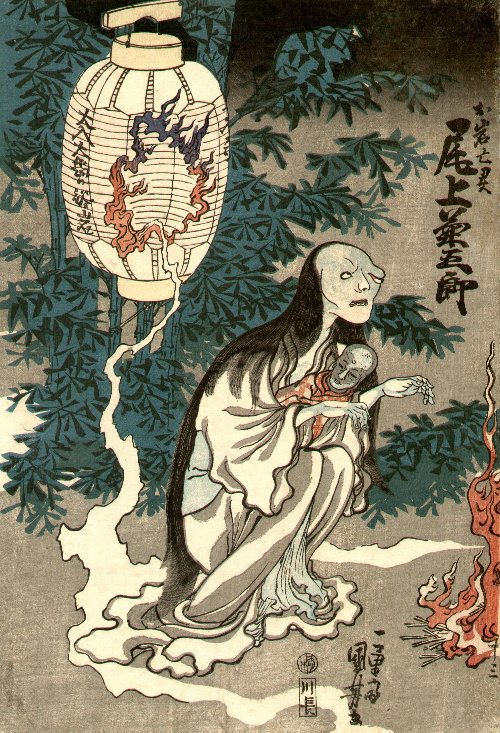
Each nation has its fair share of mythical creatures but Japan has all the more. As explained above the existence of Yokai goes way back in ancient times. The first proper book to write about Yokai and it’s over a hundred types was published in 1776 with the title Gazu Hyakki Yako and unlike other places in the world, the Japanese have decided to bring Yokai all along with them to the modern world. Yokai is present in all ways and forms. Either you watch well-known Animes such as Pokémon or other darker series such as Inuyasha, you will quickly realize Japan has a deep-rooted connection with the supernatural forced and its beings. They are everywhere. Check out this handy guide if you want to know how Pokémon and Yokai pair up today.
Yokai is an umbrella term that is widely used when talking about all sorts of spirits, fairies, and even ghosts ( although these rather fall into the other Obake category meaning all things pretty harmful such as demons, ghouls or monsters). While the proper word used for the spirit should be Kami, Kami has such roots with the ancestors of families that the word Yokai simply doesn’t carry. It’s rather kept for those who rather look like mythological creatures and every single one of them has their own story.
When it’s most likely to spot a yokai? According to old folk tales you are most likely to encounter yokai in the twilight hours shortly before sunset.
Ghost season: unlike in Europe and in all other countries under Western influence, where the late autumn is the season of the dead, in Japan, it’s the killing summer. I will write a separate blog about this and about the largest festival celebrating the dead, the Obon which is the Japanese Day of the dead and is traditionally held mid August when the heat is at its highest.
Kami, Yokai, Yurei or O-bake (Bakemono)?

There are various different words in Japanese for ghosts, supernatural beings with Yokai and Kami being some of the most popular ones. The difference is, that while Yokai refers to spirits that go on to live in something else or have magical powers Kami are rather spirits that are often associated with family and ancestors. Yurei is the name used for the classical ghosts but have no legs. O-Bake or Bakemono represents the most frightening sorts of ghosts and mythical creatures. In this series, I will focus on Kami and Yokai but due to the extreme number of ghosts, I may write separate sections on the various creatures of O-Bake and Yurei later on.
The various types of Yokai:
After careful consideration I’ve decided to represent Yokai in the following categories:
- Yokai as supernatural creatures ( spirits, semi-gods/demi-gods or other creatures)
- Yokai in real-life animals
- Yokai/Kami which live in objects or does not have a definite form
In part 1 of these series, I will feature those Yokai which are definitely supernatural creatures and have magical powers.
- Yokai as supernatural creatures
A great deal of Yokai are creatures that come from mythology. They may look somewhat like people or somewhat like an animal but they are neither of them. It’s hard to distinguish yokai from the supernatural creatures but I did my best to do so. Mostly I tried to sort those out which do have contact with humans and which affect human lives this or that way. The word also includes the fact that yokai have magical powers and that they are rather spirits than ghosts or ghouls.
Zashiki Warashi

This spirit is a weird one because it’s as much a yokai as an engimono or lucky charm. Zashiki Warashi – the guestroom child looks like a child wearing kimono and most often than not, people can hear it or see small footprints in their home. People in Japan know all well, that housing a Zashiki Warashi is considered great luck and often invites prosperity and safety. This yokai is said to bring a large amount of luck and fortune to any home. This is why it’s really suggested to leave sweet or cake for it from time to time and respect it. If someone happens to spot the Zashiki Warashi they need to be especially kind to him. While this yokai is a little mischievous but just like a young kid, therefore it never causes harm. It’s presence effectively scares all the evil away. When this yokai moves out of a home, that’s considered a stroke of really bad luck and often makes the owners of the home move out in a hurry too.
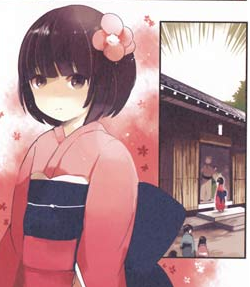
Baku:
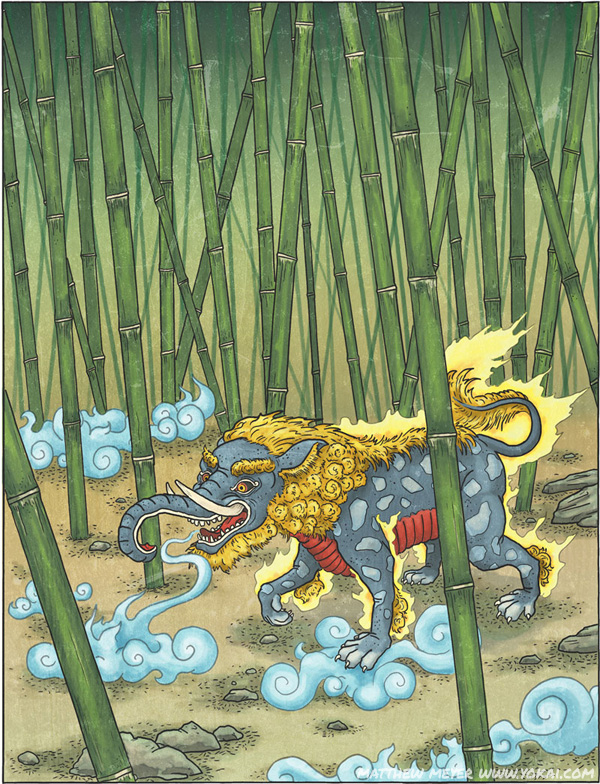
Baku is another lesser-known yokai internationally but it’s nevertheless important. If you want your nightmares or bad dreams go away, then it’s essential you have a Baku nearby. It’s pretty easy to spot as it has the head of an elephant, the legs of a tiger, the tail of an ox and the body is probably of a fox. These creatures actually consume the bad dreams and they can also have protective powers of the territory they live in. You can most likely see the image of Baku stitched, sewed or embroidered in pillows. It’s also featured on talismans. Nowadays Baku is also featured in new videos and in a game that’s called Yokai Watch and is very popular among gamers ( similar to Pokémon).
Tengu:

When you happen to watch documentaries about Japan, then sooner or later you will run into at least one Tengu. They love to feature these funny or scary-looking creatures, especially because of their extremely long, basically phallic nose structure although it’s important to note that there are many types of tengu which don’t have a large nose at all. In many areas, it’s often only the head of the Tengu that is shown. But the full creature is also gifted with a huge pair of wings. They can be often featured riding white foxes. While having large noses they are also adept at changing other people’s nose for fun or for revenge. Since they are associated with the mountain monks or Yamabushi there are also stories about very old yamabushi actually becoming a Yokai.
Origins:
Tengu, like so many creatures, originates from China. According to the mythology, Tengu is in fact half-bird, this way, the nose can also be taken for beaks. Tengu varies in shape. There are smaller tengu and larger, monstrous like Tengu. The spirit or yokai itself quite romantically derives from the spirits. The most popular and most often featured Tengu is the „Daitengu” which comes with the long nose and red face and head. These are so powerful they often have their own mountain as a living area which they don’t share with another tengu. Other tengu looks more like birds. Such is the Kotengu which is often featured with the head of a bird and the body of a human. In the 9th-10th century, most of the disasters and fires were attributed to the Tengu.
Their superpower: Tengu has the ability to shapeshift especially into a specific type of birds such as black kit or kestrel. They can also have a human shape or become invisible. They are keen on tricking people with all sorts of weird visions. They are often depicted carrying a feathered fan. Daitengu has control over the wind, they can possess human and animals likewise.

Bad habits: Tengus in nature are mischievous like most Yokai. They are keen to kidnap children. Back in the old days the career of Tengu rather started out as of a demon or oni. They were also called the reasons behind many natural disasters and other unlucky happenings. They can also tend to abduct people. Humans used to look for popular Daitengu and beg them to teach them their magic.
Good habits: When they become like someone the tengu are very strong defensive nature, therefore, lots of gates are also guarded with a pair of wild-looking half-bird tengu. If they are in their good spirits, Tengo, however, can also be keen to find and return kidnapped children to raise them and teach them their magic. These lost men were often looked at as witches and were feared.
Today, Tengu are mostly regarded as guardians with their positive characteristics emphasized instead of the negatives.

Natural habitat: Tengu love to hide in the mountain areas where they can largely remain undisturbed. They are also often said to accompany the men living in the mountains called yamabushi. They are said to live in the mountain area around Kyoto and around Tokyo especially. They are often the protectors of mountains and this way, Shinto temples and shrines feature Tengu their exit who are there to provide protection.
The three greatest tengus are:
- Soujoubou of Kurama (Kyoto) also known as Kuramayama Soujoubou
- Taroubou of Atago (Kyoto)
- Jiroubou of Hira (the Hira Mountains are west of Lake Biwa)
Protectors of shrines include Atagoya Taroubou in Kyoto: This tengu protects the Atago shrine, Izuna Daigongen the tengu of Mountain Takao and many more.
How to spot them: from the 13th century, there are more tales where Tengu disguise themselves as Yamabushi those ascetic people who live in the mountains far from civilization on their own choice.
Tengu tours: in Kyoto, there’s the Kurama to Kibune hike (of Yoshitsune fame), and in Tokyo, the most popular hike in the city is Mt Takao.
Other interesting facts: they have in fact counted the number of Tengu back in the day and they have managed to count 125 thousand of them. While the largest tengu have their own mountains many others do not have such a strict living place and they keep moving until they find their ultimate mission in protecting a place or a building. Tengu is often featured as the enemy of Buddhism.

Tengu is one of the most popular folk creatures in Japan and is starring in tons of stories. Each mountain with their respective tengu holds yearly festivals to pay respect to their tengu. One of the most popular Tengu festivals is Shimokita Tengu Matsuri that’s held in the winter during Setsubun in Shinryuji temple. The oldest festival is held in Osaka every October. When there is a festival held to pay respect for a tengu people are advised not to hang their laundry outside.
Kappa – the river child
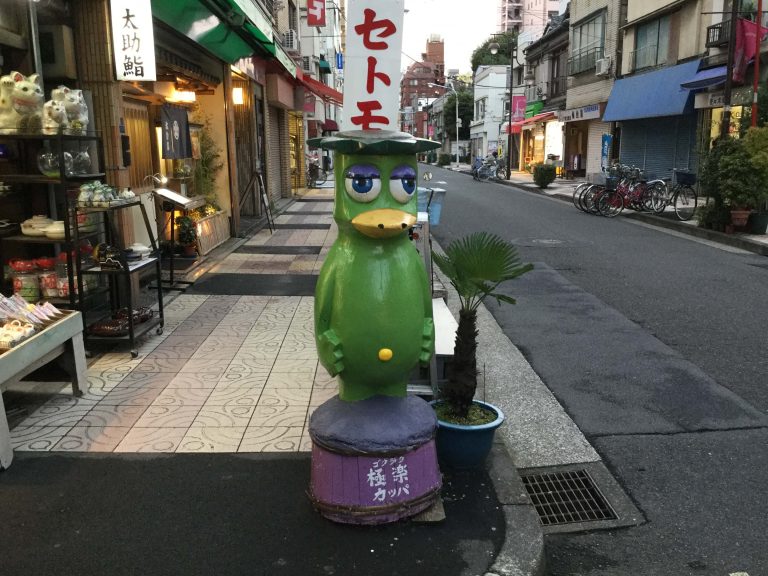
The funny-looking kappa was not always such a funny creature. Being one of the most popular yokai of all time, Kappa back in the day, it was rather considered dangerous and creepy. it’s definitely a water spirit and you can guess that solely by its amphibian looks Today, thanks to its funny presentation it rather resembles a Pokémon than of an actual dangerous creature. It’s often featured in the front of stores much like a tanuki or a Maneki Neko, as a form of Engimono. Large Kappas are so potent in power that they are often considered as semi-gods.
Origins: While today’s representation of Kappa strongly resembles a funny platypus back in the old day Kappa looked rather like a frightening green reptile-monster. It’s an amphibious creature that lives in the water and it’s about 1-1,2 meters tall. Its name Kappa is not only featured as a Japanese sportswear brand. Using its love for cucumber, various restaurants and eateries call the cucumber sushi as Kappa maki. No matter how exactly it is featured one thing is for sure. As Kappa cannot physically stay alive without the presence of water on its body, all of them have to wear a tiny hat on the top of their head, that carries water. While some stories say it derives from the soul of dead children, other friendlier stories say it may derive from the Japanese otter or the salamander.
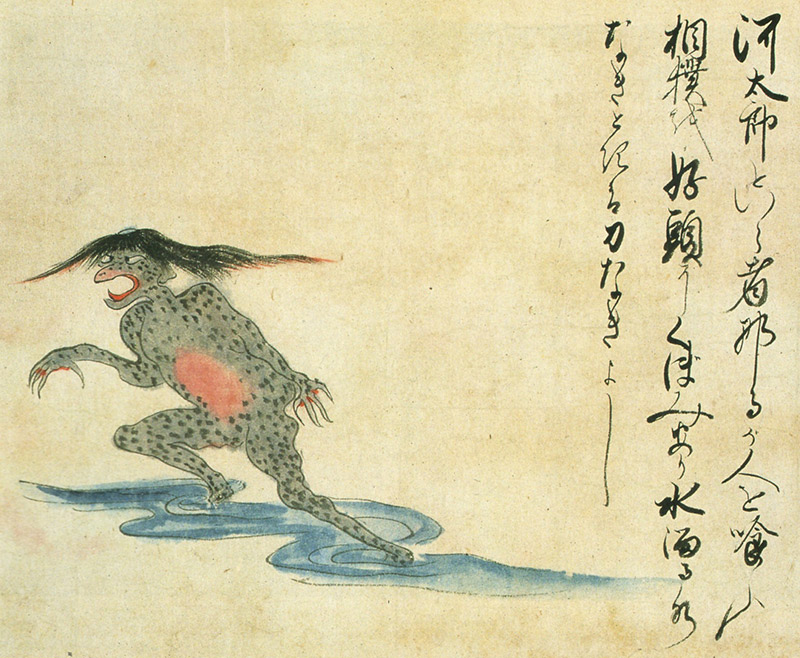
Their superpower: Kappa is dangerous as it is, without having to pretend to be anything else. Even as of today, there are warning signs next to water, warning especially children to the possible presence of a Kappa. It’s a creature that used to be way beyond mischievous. Their usual habit is to catch people or animals and just like crocodiles they hold them underwater until they drown. As they are too small to hold down someone larger or healthy, they are focusing on catching kids. This means Kappa is a folk story that is often used to warn kids not to walk or stay next to the water.
Kappa also used to attach people through their ass holes ( however weird this seems). The best weapon against a Kappa is to make it bow. Because then, its cap which holds water would fall off and it would die.
Kappas are featured in many stores where they do bad, but in many of them, they also show the ability to repent and try to make their bad act good. Kappa is also mainly said not to catch people because they want to eat them, but because of a thing, which supposedly we all hide in our bodies. This mystical thing is said to look like a ball and in Japanese, its called shirikodama. According to the Kappa related stories, this substance is best to be reached through the anus.
Kappa has recently turned from bad to funny. Today, it’s largely used as a lucky charm. As said above Kappa is very famous for its obsession with cucumber.

Unique features: Kappa, as we can see, is more than mischievous but it can also do good. There are many stores about Kappa which appease their craftiness when it comes to medicine and healthcare. There are in fact stories where Kappa help in healing humans. According to Japanese, if you yank off a Kappa’s arm ( if it tries to reach you from a toilet) then they can make a deal with you and teach you their healing secrets in return for their arm ( if they get these back in time they can reattach them). Another very weird thing about Kappa is that they actually get out of their skin to be able to sleep. But this renders them defenseless too.
Where to spot them and places dedicated to Kappa: they would live in waters, like ponds, rivers, and swamp. There is a city that has a well-known Kappa bridge which features tons of rather cute looking Kappa figurines in front of shops.

At Sogenji Temple in Asakusa, Tokyo, also known as Kappa-dera, the story is that the area was subject to repeated floods until a bunch of kappas helped build flood-control structures. So now they are venerated there. For you skeptics, Sogenji even has a relic to prove it: the mummified hand of an actual kappa.
Kappa has become perhaps the most used Yokai in all sorts of water and food-related Japanese advertisements. Its fearful nature is almost completely gone. Read more stories featuring the Kappa visiting one of these websites: Yokai.com or on Tofugu.
Benzaiten

Benzaiten is the goddess of art she is one of the 7 gods of good luck and originates from India. Wise and skilled in painting and writing, she carries a biwa (a traditional Japanese stringed instrument). Benzaiten is also often escorted by a sea snake. She is a key spirit of flowing water, she is the patron saint of musicians and performers. Shrines for her with images of snakes are often set up near ponds. Benzaiten is sometimes depicted with a coiled snake sitting on top of her head. In rare instances, she also appears in a very special avatar, with the body of a coiled snake and the head of a human being. This avatar is known as Jatai-Benzai, or “Snake-body Benzai.
In her most common avatar, she is seated with one leg pressed down flat on the ground and the other sticking up vertically. Folklorists believe her connection with music is rooted in the belief that human speech and music originated in the soft sound of running water. In other avatars—many of which are depicted on statues in ponds’ she holds weapons or has the body of a coiled snake.
Benzaiten is regarded as a bringer of wealth and prosperity. Kevin Short wrote in the Daily Yomiuri: “Benzaiten is a deity of Buddhist origin, The “ten” in her name refers to a particular class of Buddhist deity, usually called Deva in English. Benzaiten, called Sarasvati in Hindu, was originally an Indian river spirit. After being absorbed into Buddhism, she made the long trek across central Asia to China and the Korean Peninsula on to Japan, reaching here by at least the early eighth century, but probably even earlier.
In Benzaiten’s case, the spiritual essence of the new water spirit was simply fused into that of Itsukushima-Hime, a native goddess specializing in presiding over waterside environments. Itsukushima sports an excellent pedigree, well-grounded in Japan’s formal mythology. She is one of three great goddesses that came into being when the great Sun Goddess Amaterasu chewed and spat out her brother’s longsword. Along with her two sisters, Itsukushima is formally worshipped at the famous Itsukushima shrine on Miyajima island in Hiroshima Prefecture.
Nuppeppo:

This Yokai is a tricky one in many ways. First of all, it’s extremely stinky and it looks like a melting soap, second of all it’s very hard to catch. The tales talk about Nuppeppo to be so stinky that everyone can tend to feel their bad smell way before spotting one. This yokai looks like a ghost-sort-of a creature. It’s part of the Japanese folklore from the Edo Period and it has a very important superpower. It’s said that if anyone tastes Nuppeppo then this act will cure them from any illness and grant them superpower. That’s also why Nuppeppo is said to be one of the main ingredients of magical medicines.There are several stories talking about shoguns going on missions to catch a Nuppeppo and mostly they were unlucky.
I hope you liked this first part. It literally took me a year to properly compose these series. Although Yokai were endangered in the Eighties and Nineties now they are back with a bang and famous as ever. I hope I can give some comprehensive information about these very interesting creatures.Yokai are featured all across Japan in ads, on photos, on paintings and in the form of sculptures. Let me know if you feel that I have left some out.
In the upcoming series, I will enlist the yokai which are also real-life animals.
